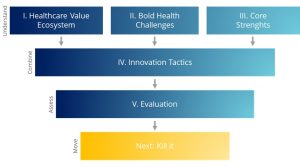Healthcare, as an industry, is in urgent need of innovative, yet robust business models. We present a 5-step framework for getting from whiteboard to boardroom. “With a robust and structured process in place, innovation in healthcare can re-emerge,” said Frederik Bohn, Venture Developer at FoundersLane.
A 5-step healthcare innovation framework
With a robust and structured process in place, innovation in healthcare can re-emerge. The following framework is tailored to participants who are already active in the healthcare sphere and aim to create new innovative digital solutions.
In healthcare, many great ideas run out of oxygen, simply because they fail to understand the multifold challenges manifest in the industry. Therefore, the first three steps of this framework provide a system to gain a thorough understanding, before deciding whether to proceed with your idea.

Step One: Healthcare Ecosystem & Value Chain
In the beginning, it is essential to identify valuable insights along a tailored value chain. Map out the activities in your targeted field from end-to-end and be as specific as possible. Medical devices, for example, start with prototyping in research and development, before they move to preclinical testing to obtain approval and so on. Map out the relevant stakeholders in each of the steps. Who is doing the preclinical testing, who is needed for tests, who is signing a potential approval?
By carefully analysing the existing ecosystem—vertical and horizontal stakeholders—you can begin to map out the entire value chain.
Step Two: Bold Health Challenges
Creating and implementing a new innovative idea is challenging. But, the hard graft of finding a solution is worthwhile if you have the intrinsic motivation to solve a certain problem in the world. Healthcare is not without its fair share of challenges: pushing new healthcare systems into action, reducing inaccessibility, and driving the adoption of precision medicine. Be bold, but be specific. In the end, your focus should narrow to a few challenges that you would be eager to solve.
One such challenge is improving accessibility to healthcare, which according to Zebra’s The Future of Healthcare: 2020 Hospital Vision study, new mobility tech will attempt to solve. In their study, nearly three-quarters of the survey’s respondents said mobile technology resulted in better patient care, with more than half suggesting that patient care also costs less when mobile tech is used.
Step Three: Inner Strengths
The essence of this step is to explicitly formulate your strengths and expertise. A useful approach here is the resource-based view: Resources of the firm can include all assets, capabilities, organizational processes, firm attributes, information, and knowledge. But, they must be valuable, rare, inimitable, and organised (VRIO.)
As a medical device producer, you might know how to produce MDR approved devices, have a production-line in place, or have a dedicated sales team ready to push a new innovation into the market. As a clinical operator, you might have the capability to run clinical trials at speed, can generate large-scale patient data, or know the requirements for clinical objects from bedding, lights, or rehabilitation products. Become clear on what you can offer to accelerate innovation and to focus your resources on areas where you hold a distinct advantage.
Step Four: innovation tactics
Innovators, above all, must have a vision. One approach is to define the goal and from there to pull back and plan how to get there. By working backward from the goal, innovators can focus on customer needs and testable steps, but with a defined outcome in mind. The mission is to identify a potential gap in the ecosystem, and to create a pathway that ends up filling that gap and solving a problem.
One vision revolves around leveraging healthcare mobility to solve access inequalities in healthcare. Those living outside urban areas, increasingly lack the opportunity to receive adequate care when they need it. Knowledge of treatments could be leveraged with technology. Kinderheldin, for example, addresses this issue for midwives.
Step Five: Evaluation
When it comes to the evaluation stage, the idea innovation process combines the trifecta of desirability, feasibility, and viability, as identified by IDEO in the early ’00s. What is most important for each of the pillars? Think of the most relevant criteria and rank these from 1-10. On top, a weight can be added to fine-tune each characteristic.
Criteria used to evaluate ideas range from user side factors: the intensity of existing problems to the impact on people’s health, business side factors: market size or growth potential, and company side factors: building on core strengths such as utilizing production, treatment knowledge or employees. Watch out if any metric rings an alarm bell when analysed. When an idea makes it this far, the goal then becomes, ironically, to kill it.
When to kill it
Often, it is the case that strategies never take any shape at all, condemned to see out their days as lowly scribbles on a whiteboard. To bridge the gap to the real world, your job is to try to kill your innovation idea—in a structured way. At this point, you have a business case to build on. However, typically it is built solely on assumptions. Assumptions are the mother of all mistakes, but in the case of an innovation strategy, it can mean sudden cardiac death for your idea. Get a pen and paper and write down a maximum of ten assumptions, that if proven true will be a flatline for your idea. Following entrepreneur Steve Blank, graph them out based on your current level of uncertainty and the potential impact on the business case and address the most prescient ones first.
In brief, this framework is just one approach to overcome the unique obstacles in the healthcare industry. But it is a proven concept to carve out a functioning business built on solid foundations.












